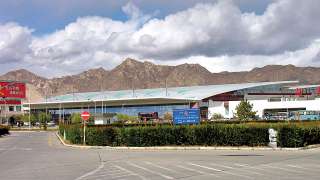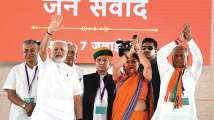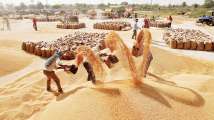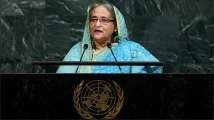DNA OPINION: Farmers suffer while leaders have a field day

Farmer , AFP
Late last night a revolution died, failed by leaders who are more interested in immediate gains than the interest of the farmers. This has been the tragedy of the farmers for a long time. They have lacked genuine leadership since the days of Charan Singh. Current leaders are pale shadows of their forefathers. They are surviving as leaders not because of their leadership qualities or their desire to do anything for the farmers, but because their previous generations did the right thing.
The farmers have a genuine reason and cause to agitate as the pain they are suffering is real as well as old. They are in agony because the system refuses to understand or address their problems. The bureaucrats would like to obfuscate the problem so that it cannot even be defined. There are experts in think tanks, including the government ones, who do not care.
But the longer a problem is buried, the more dangerous it becomes as it will sooner or later burst out into the open. A pressure cooker works because it allows hot air to be released at frequent intervals. While the farmer leadership can be compromised by being promised a ticket from Bijnore or Baghpat and an agitation can be killed temporarily, the problem will not fade away.
If the problem is not addressed, it will affect the voting dynamics during the general elections in 2019. The problem is pricing or minimum support price (MSP), to be specific. Everything else around is the symptom of this singular issue. The objective of setting the price is to ensure that the farmer is able to earn an income. This is important as 59 per cent of the country's total workforce is still dependent on agriculture while its share in the GDP is just 23 per cent.
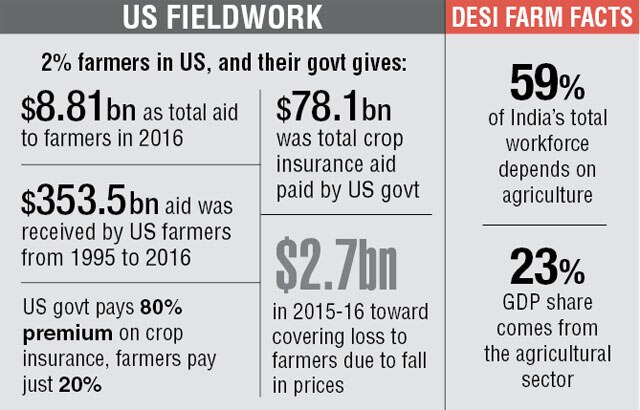
This shows the disproportion of the population surviving on very little income. The system of MSP is supposed to ensure not just survival of two-thirds of Indians, but also to maintain a crucial part of the ecosystem. In less populous and developed countries like the US, where just 2 per cent of the population is dependent on agriculture, subsidies direct and indirect, are given by the government to ensure a certain level of income for the farmers.
US-based farmers get an income on the basis of acreage and crop even before they cultivate a crop. And the government insures them if there is any loss of income on selling the crop.
Even though such a large population depends on agriculture, mandarins counting the beans have not been able to develop a plan and method for delivering value to the farmer. Our economists from the Chicago school have shied away from any comprehensive solution as they come with a model that says no subsidy. The market rules supreme.
How does a small impoverished seller with a perishable product negotiate any rate with a buyer – a buyer who not only controls the prices, but storage of the perishable product, the loan for production and every other aspect of the market? There is no regulator in this market and the government enters this market as a buyer and wants to enforce an artificial price or MSP on all buyers. This, in a nutshell, is the dynamics of the system.
This leads to a simple question: what should the price be for agricultural produce? Any price has to be based on the production cost. There are two formulas for cost. The first is based on price of seed, labour (human, animal and machine), fertilizer, insecticides and other miscellaneous costs and is called A2. Added to this is the cost of family labour (FL).
The second formula also takes rent and interest on owned land and depreciation on agriculture equipment. The final cost of production is C2=A2+FL+rent and interest+depreciation. This is what the Swaminathan Committee had suggested as the cost and this is what the farmers want. But this is what they will not get. Resultantly, loan defaults, bankruptcy and suicides will continue.
Learned agronomist MS Swaminathan offered a formula for calculating this price. The formula defined what all inputs – labour, seed and equipment – should be taken into calculations. This formula called C2 also defines that the opportunity cost of the land used for agriculture should also be included in the calculation. It also defines rent for the land. Successive calculation of production cost has ignored rent or the opportunity cost. As a result agriculture land is not longer profitable to till in several parts of the country.
Farmers want the MSP to be 1.5 times of C2 as suggested by the Swaminathan Committee, not 1.5 times of A2+FL, which the government gives. This discrepancy on what constitutes the production cost is the problem and is continuously obfuscated to prevent the real picture from emerging. Farmer leaders cannot present the case as economists and economists do not want to represent the farmers' point of view. Even with the enhanced MSP for the Rabi crop has the formula been followed or the discretion for the price hike has been a bureaucrat's opinion.
The politician is confused by both and the end result is that the problem festers on. It is likely that the farmers may come back to Delhi on November 29 or 30 to press for their demands again.





